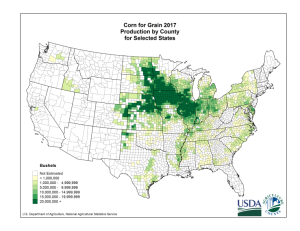I like to think of myself as a moderate in all things veterinary nutrition. Avoid known toxins, avoid any particular food or ingredient that your individual dog or cat does not seem to tolerate, feed a balanced diet in an amount to maintain a healthy body condition, and try not to tie your pet food choices to someone else’s ethical eating standards. Especially with the recent attention on grain-free diets, it is important for caregivers to understand when market trends, rather than animal nutrition, are shaping their dog or cat’s diet.
So where did the idea that grains are somehow bad come from?
Simple. It came from pet food companies that were trying to distinguish themselves in a competitive marketplace. It had nothing to do with quality, food safety or nutrition and all about selling pet food.
Corn and other whole grains somehow became the “wrong” foods to feed dogs and cats about 10 years ago. My personal theory was that this shift in pet food ingredients was a combination of: 1) the pet food recalls in 2007 due to contaminated wheat and rice ingredients; 2) an increased awareness of “hidden allergens” in people foods starting in 2004 when labeling laws for people foods required human food manufacturers to start listing all potential food allergens whether intentionally added or not; 3) the availability and promotion of what was then a new category of plant ingredients, the pulses (i.e., peas and other legumes), starting in 2010; and 4) smaller pet food marketing companies trying to make a name (and a lot of money) by distinguishing themselves from the established competition.
Companies big and small like to highlight the differences between their foods and their competitor’s products, something that has been done from the beginning of food marketing times. Since the vast majority of over-the-counter dog and cat foods were and still are largely manufactured in the Midwest where corn and wheat are grown and easy to get at a good price point, smaller companies that targeted pet owners willing to pay more for their pet food began using less common and more costly pet food ingredients like potato and peas. The problem with the explosion in sales of grain-free pet food is that these ingredients are relatively new to the pet food marketplace and don’t have the decades of feeding trials and nutrient and digestibility standards to demonstrate that they are safe for long-term, chronic feeding.
This Nutritionist’s quasi-concern with corn.
I don’t have any concerns about corn as a stand-alone food or ingredient in pet foods. Corn is high in the essential-for-life omega-6 fatty acid linoleic acid (LA) so it makes balancing home-cooked diets easier, but is also practically devoid of the essential-for-optimal-skin-health omega-3 fatty acid alpha-linolenic acid (ALA) so by itself isn’t a complete food. ALA was not recognized as a nutrient requirement until publication of the National Research Council’s Nutrient Requirements for Dogs and Cat book in 2006 and it still hasn’t been incorporated into the AAFCO Model Bill and Guidelines for pet food manufacturers. Meaning diets that are made by manufacturers who use large amounts of corn (high in LA and variable digestibility depending on quality standards of the manufacturer) that don’t follow new developments in the field of dog and cat nutrition can legally sell diets that are listed as “complete and balanced” that are potentially imbalanced in essential fatty acid levels and may cause dull dry skin, itching and flaking and excessive shedding in some animals. This isn’t an “allergy” to corn, or even an indication that corn is bad, but that the essential fatty acids in that diet aren’t balanced for that individual dog or cat’s needs.
What about gluten?
Gluten is just the generic term for protein found in plants. People with celiac disease are sensitive to the specific glutens found in wheat, rye and barley called gliadin and glutenin, but have zero problems with the gluten found in rice or corn. There is some evidence that Irish setters and soft coated wheaten terriers may have similar gliadin and glutenin sensitivities, but this condition has not been seen or proven in cats or other dog breeds. The disconnect with pet foods is that from a legal labeling perspective “gluten” is the generic food science definition of a plant protein (i.e., rice gluten, wheat gluten, corn gluten) and is what shows up on labels even though the physical structures of each of these plant proteins are all unique. Over the last decade, small and medium-sized pet food marketing companies have started to exploit peoples lack of awareness of these differences to demonize all grains in pet foods in order to sell more of their own “grain-free” products.
What about dogs and cats with grain allergies?
The majority of the gastrointestinal food sensitives that I see and treat in dogs and cats are not true allergies. True allergies are eosinophil mediated type III hypersensitivity reaction resulting from an antigen-antibody complex that triggers a cascade of immune-mediated problems resulting in inflammation and dysfunction of the skin or intestinal tract. If your dog or cat has an allergy to any given ingredient then absolutely avoid that ingredients, but what I tend to see are mostly adverse food reactions caused from feeding poorly digestible diets or ingredients that alter gastrointestinal microflora causing bacterial dysbiosis (imbalance of “good” vs “bad” bacteria that are normal inhabitants of the intestinal tract). It is these bacterial-induced changes on the environment in the digestive tract that affect its function (nutrient absorption and holding poop until the appropriate time and place) that cause the signs that can keep dogs, cats, and their caregivers up at night (literally and figuratively).
What are the benefits of including whole grains in a diet?
Grains like barley, wheat, rice and corn provide essential nutrients like protein, amino acids (the building blocks of protein), +/- the essential omega-6 fatty acid linoleic acid (essential for skin and coat health), vitamins like thiamin and riboflavin (B1 and B2), and minerals like magnesium and selenium. They also provide a source of dietary fiber and while fiber is not considered “essential for life” and is not included in the AAFCO nutrient list for dog and cat diets, is actually essential for normal intestine health and function. As I’ve written before in this blog, fiber, especially fermentable fibers feed the gut bacteria that feed the colon cells and keep them happy and healthy. And there it is one thing that we can all agree on is that eyes are the windows to the soul and poop is the herald of health.
The bigger picture on grains …
We grow a lot and eat a lot of grains and cereal crops in the United States whether as individual ingredients or fractions of ingredients (think rice flour and soy protein). These are less expensive sources of nutrients than animal proteins so companies who are trying to reduce costs and maximize profits (which is ALL OF THEM) will use easily sourced plant-based ingredients whenever possible. The last 50+ years of commercial pet food production has shown us that these foods are safe and nutrition sources of nutrients for dogs and cats when processed and stored correctly. Corn, wheat, sorghum, barley, and rice have been used successfully for decades in dog and cats foods, they are palatable and digestible by both dogs and cats, but, depending on the amount and quality of the plant-based ingredients digestibility may not be great and since digestibility is inversely related to poop volume: more digestible = less poop; less digestible = more poop.
If your individual dog or cat has a known sensitivity to any particular ingredients (plant or animal sourced) then absolutely avoid that particular food in your individual dog or cat’s diet. This is also true if that dog or cat is sensitive to chicken, emu, elk, or quinoa. Dogs and cats can develop sensitivities or allergies to any protein, whether it comes from a plant or an animal. I realize all of these statements make me unpopular among certain self-appointed pet food advocacy groups and individuals, but aside from foods that contain known toxins or are harmful to dogs and cats, there is no one perfect diet or set of ingredients for each individual dog or cat.
Happy Feeding!
Lisa P. Weeth, DVM, MRCVS, DACVN





